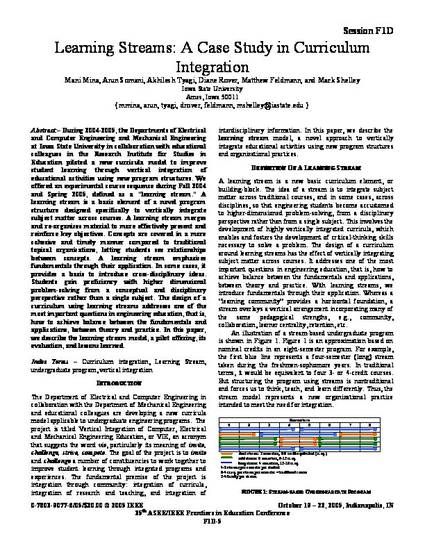
During 2004-2005, the Departments of Electrical and Computer Engineering and Mechanical Engineering at Iowa State University in collaboration with educational colleagues in the Research Institute for Studies in Education piloted a new curricula model to improve student learning through vertical integration of educational activities using new program structures. We offered an experimental course sequence during Fall 2004 and Spring 2005, defined as a “learning stream.” A learning stream is a basic element of a novel program structure designed specifically to vertically integrate subject matter across courses. A learning stream merges and re-organizes material to more effectively present and reinforce key objectives. Concepts are covered in a more cohesive and timely manner compared to traditional topical organizations, letting students see relationships between concepts. A learning stream emphasizes fundamentals through their application. In some cases, it provides a basis to introduce cross-disciplinary ideas. Students gain proficiency with higher dimensional problem-solving from a conceptual and disciplinary perspective rather than a single subject. The design of a curriculum using learning streams addresses one of the most important questions in engineering education, that is, how to achieve balance between the fundamentals and applications, between theory and practice. In this paper, we describe the learning stream model, a pilot offering, its evaluation, and lessons learned.
Available at: http://works.bepress.com/diane-rover/10/

This conference proceedings was published as 78. Mani Mina, Arun Somani, Akhilesh Tyagi, Diane Rover, Matthew Feldmann, and Mack Shelley, “Learning Streams: A Case Study in Curriculum Integration,” pp. F1D-5–F1D-9 in the Proceedings of the 35th ASEE/IEEE Frontiers in Education Conference. October 19 – 22, 2005, Indianapolis, IN : Institute of Electrical and Electronics Engineers (2005).0-7803-9077-6/05. Posted with permission.